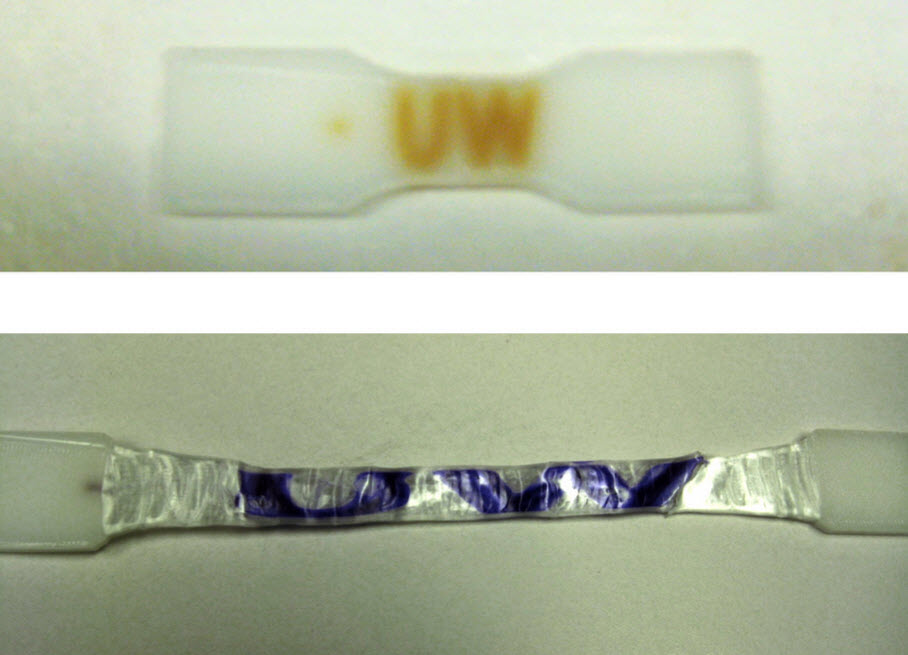How to 3D-print a custom low-cost mechanical sensor
February 12, 2015

The top panel is a 3-D printed plastic tab with the letters “UW” printed in a slightly different material; the bottom image shows the result of stretching (credit: A.J. Boydston / UW)
University of Washington scientists have printed out molecules that can respond to their surroundings.
As a test, they created a bone-shaped plastic tab that turns purple under stretching, offering an easy way to record the force on an object.
“At the UW, this is a marriage that’s been waiting to happen — 3D printing from the engineering side, and functional materials from the chemistry side,” said Andrew J. Boydston, a UW assistant professor of chemistry. He is corresponding author of a recent open-access paper in Applied Materials and Interfaces journal.
To create the test material, they fed polycaprolactone into one print head of a 3D printer (this is similar to the flexible filament used in conventional 3D printing). For the other print head, they used a plastic that is 99.5 percent identical, but designed to have occasional insertions of a molecule, spiropyran, that changes color when it is stretched.
Low-cost instant customized sensors
The result was a printed piece of white plastic with barely visible stripes that turn purple under force. It acts as an inexpensive mechanical sensor with no electronic parts. The whole device took about 15 minutes to print from materials that cost less than a dollar.
Such a sensor might be used to record force or strain on a building or other structures. The researchers plan to create a version that records the speed of the force or impact, which could allow for a football helmet that changes color to indicate a possible concussion.
Different instructions can program the machine to print the plastics in various ways: with the color-changing part in stripes in the middle, completely encased in the other plastic, or in any other desired shape.
Varying how the plastic is made could allow a device to respond in different ways. For example, a material could record load history.
The research was funded by the University of Washington.
Abstract of 3D-Printed Mechanochromic Materials
We describe the preparation and characterization of photo- and mechanochromic 3D-printed structures using a commercial fused filament fabrication printer. Three spiropyran-containing poly(ε-caprolactone) (PCL) polymers were each filamentized and used to print single- and multicomponent tensile testing specimens that would be difficult, if not impossible, to prepare using traditional manufacturing techniques. It was determined that the filament production and printing process did not degrade the spiropyran units or polymer chains and that the mechanical properties of the specimens prepared with the custom filament were in good agreement with those from commercial PCL filament. In addition to printing photochromic and dual photo- and mechanochromic PCL materials, we also prepare PCL containing a spiropyran unit that is selectively activated by mechanical impetus. Multicomponent specimens containing two different responsive spiropyrans enabled selective activation of different regions within the specimen depending on the stimulus applied to the material. By taking advantage of the unique capabilities of 3D printing, we also demonstrate rapid modification of a prototype force sensor that enables the assessment of peak load by simple visual assessment of mechanochromism.